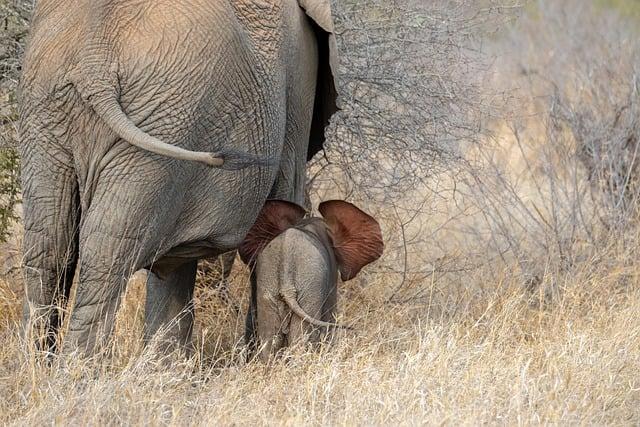In a arguable transfer geared toward addressing a rising humanitarian disaster, the Zimbabwean executive has introduced plans to cull 200 elephants to complement meals provides for electorate dealing with critical starvation because of an ongoing drought. As local weather alternate exacerbates climate irregularities within the area, tens of millions are left suffering to protected fundamental sustenance, prompting government to show to drastic measures. This determination has sparked global debate over flora and fauna conservation and the moral implications of the usage of flora and fauna assets to relieve human struggling. On this article, we discover the context of Zimbabwe’s drought, the rationales at the back of the cull, and the wider implications for conservation efforts and native communities.
Affect of drought on zimbabwe’s Meals Safety and Flora and fauna
The continuing drought in Zimbabwe has created a vital state of affairs affecting each meals safety and flora and fauna conservation. As crop yields decline because of inadequate rain, communities are dealing with critical starvation, inflicting the federal government to take drastic measures. The verdict to cull elephants isn’t simply a flora and fauna control factor; it embodies the combat between human and flora and fauna survival within the face of environmental disaster. The elephants, majestic symbols of the area, are changing into a useful resource in a determined effort to feed the inhabitants, highlighting the unsettling possible choices that communities should make when confronting the realities of local weather alternate and shortage.
Additionally, the results of the sort of culling initiative prolong a long way past rapid meals reduction. It raises profound questions on biodiversity, sustainable control, and the stability of ecosystems the place those elephants roam.Balancing the wishes of human populations with the conservation of flora and fauna calls for thorough methods that cope with the basis reasons of drought and meals lack of confidence. Figuring out those dynamics is the most important for long run policymaking, that specialize in long-term sustainable agriculture, water useful resource control, and group resilience. The next desk outlines the possible affects of drought on each human communities and flora and fauna in Zimbabwe:
| Affect Space | Human Penalties | Flora and fauna Penalties |
|---|---|---|
| Meals Safety | Larger starvation and malnutrition | Lowered crops and habitat loss |
| livelihoods | Financial instability for farmers | Displacement of animals because of habitat degradation |
| Human-Flora and fauna Warfare | Threatened group protection | Endangered species from culling or poaching |

Figuring out the Necessity In the back of the Culling of Elephants
The verdict to cull elephants in Zimbabwe stems from a posh interaction of environmental, financial, and social components. Drought, which has considerably impacted the area, has resulted in meals shortages for lots of communities. Elephants, as huge herbivores, can exacerbate those crises through competing for restricted assets, resulting in increased human-wildlife conflict.The culling may also be observed as a arguable but strategic measure meant not to simplest set up elephant populations but in addition alleviate the struggling of native people who find themselves suffering to continue to exist amidst dire instances.
In addressing this factor, government emphasize the next issues:
- Human-wildlife Warfare: With dwindling meals assets, elephants steadily encroach on farmlands, inflicting crop destruction.
- Conservation As opposed to Fast Wishes: Balancing the conservation of flora and fauna with the pressing wishes of native populations is important.
- Neighborhood Engagement: Involving native communities in flora and fauna control choices guarantees their voices are heard and their wishes prioritized.
- long-Time period Answers: Discussions on sustainable practices and selection livelihoods are very important to forestall long run crises.

Ecological Issues: The Penalties of Lowering Elephant Populations
The verdict to cull elephant populations carries profound ecological implications that stretch a long way past the rapid context of feeding a suffering human inhabitants. Elephants play a the most important position as a keystone species inside of their ecosystems,influencing the construction and composition in their habitats. When elephant numbers dwindle, we possibility destabilizing native ecosystems thru various interconnected pathways:
- Habitat Alteration: Elephants lend a hand take care of the savanna and wooded area ecosystems thru their feeding behavior, contributing to crops variety.
- Water Supply control: Their motion patterns create water holes that many different species rely on all the way through dry seasons.
- Seed dispersal: Elephants are essential for long-distance seed dispersal,making improvements to plant variety and assisting wooded area regeneration.
Additionally, the long-term penalties of a vital inhabitants aid may manifest in an uptick of alternative herbivore species, resulting in overgrazing and additional habitat degradation. The stability of predator and prey dynamics might also shift, growing unexpected cascading results that adversely affect biodiversity. The next desk summarizes attainable ecological affects as a result of lowered elephant populations:
| Affect | Description |
|---|---|
| Crops Lower | Relief in plant variety as elephants forestall foraging. |
| Flora and fauna Displacement | Different species would possibly transfer out or decline because of habitat adjustments. |
| Larger Human-Flora and fauna Warfare | Adjustments in land use would possibly result in extra encounters with human populations. |

Human-Flora and fauna Warfare: Balancing Neighborhood Wishes and Conservation Efforts
The verdict to cull elephants in Zimbabwe highlights the an increasing number of pressing wish to reconcile human and flora and fauna pursuits in areas the place herbal assets are strained. As local weather alternate contributes to critical droughts, communities face meals shortages, resulting in determined measures. This example brings into focal point the subtle dance between conservation tasks and the rapid survival wishes of native populations. Key components influencing this catch 22 situation come with:
- Financial Power: with dwindling agricultural outputs, many rural households rely on flora and fauna for meals.
- Conservation vs. Livelihoods: Protective flora and fauna would possibly restrict financial alternatives for citizens suffering to make ends meet.
- Neighborhood Engagement: Involving native populations in conservation efforts can result in extra sustainable answers.
As Zimbabweans grapple with the fallout from drought-induced starvation, flora and fauna control methods should evolve.Efficient answers require collaboration amongst governments,NGOs,and native communities to make certain that flora and fauna conservation efforts additionally believe human welfare. proposals for selection measures would possibly come with:
| Choice Measures | Description |
|---|---|
| Neighborhood-based Control | Encouraging locals to supervise and have the benefit of flora and fauna coverage. |
| Flora and fauna Translocation | Relocating animals to much less populated spaces to cut back warfare. |
| Meals Help Systems | Offering rapid meals reinforce to prone populations. |

Suggestions for Sustainable Flora and fauna Control and Meals Help Systems
To deal with the demanding situations posed through flora and fauna inhabitants keep watch over whilst making sure meals safety for prone communities, it’s certainly the most important to undertake multifaceted and sustainable approaches. Targeted methods will have to come with:
- Neighborhood Engagement: Involving native communities in flora and fauna control choices promotes stewardship and sustainable practices.
- Choice meals Resources: Making an investment in agricultural building to create resilient food systems can scale back reliance on flora and fauna culling.
- Ecotourism Alternatives: Supporting ecotourism tasks can generate source of revenue whilst incentivizing flora and fauna preservation.
- Flora and fauna Corridors: Organising designated corridors for flora and fauna guarantees secure migration and decreases human-animal warfare.
Additionally, imposing efficient meals assist techniques calls for cautious coordination and concentrated on to fulfill the wishes of affected populations. Really useful practices come with:
| Program Kind | Description |
|---|---|
| Dietary Help | Offering very important vitamins to drought-affected communities, emphasizing native meals personal tastes. |
| capability Construction | Coaching farmers in sustainable practices to extend meals manufacturing in the long run. |
| Tracking & Analysis | Organising techniques for monitoring meals assist distribution and assessing its affect on group wishes. |

Lengthy-term Answers: Addressing the Root Reasons of Meals Lack of confidence in Zimbabwe
Addressing meals lack of confidence in Zimbabwe can not simply contain non permanent fixes; it calls for a complete method that tackles the underlying components contributing to this disaster. One of the most root reasons come with critical local weather alternate results, financial instability, and the unsustainable agricultural practices that weaken meals techniques. Sustainable answers should focal point on:
- Making an investment in Agricultural Generation: Enforcing leading edge farming tactics that fortify yield and resilience towards drought.
- Coverage Reform: Enacting insurance policies that offer farmers with get entry to to essential assets comparable to seeds, fertilizer, and coaching.
- Various Crop Cultivation: encouraging the expansion of drought-resistant plants to make stronger meals safety.
- Fortify for Native Farmers: Strengthening native markets to permit farmers to promote produce immediately to shoppers, thus boosting native economies.
Moreover,it is very important to foster partnerships between the federal government,NGOs,and global assist organizations to create a strong framework geared toward empowering communities. By means of integrating social protection nets and community-based programs, Zimbabwe can construct resilience towards long run shocks.A collaborative effort can lend a hand determine a sustainable meals machine that now not simplest meets the rapid wishes however ensures long-term food security, thereby reworking the narrative from dependency to self-sufficiency.

Long term Outlook
Zimbabwe’s determination to cull 200 elephants according to the critical drought underscores the advanced interaction between flora and fauna control and human survival. Because the country grapples with meals lack of confidence and the antagonistic results of local weather alternate, this arguable measure seeks to handle rapid starvation wishes whilst elevating vital moral and conservation considerations. The location highlights the pressing want for sustainable answers that stability the welfare of each human populations and flora and fauna. As Zimbabwean government navigate this difficult panorama, the global community watches closely, emphasizing the significance of leading edge methods for conservation and meals safety in a converting setting. The end result of this initiative may set a precedent for a way international locations confront equivalent crises one day.
Source link : https://afric.news/2025/02/25/zimbabwe-to-cull-200-elephants-to-feed-citizens-left-hungry-by-drought-cnn/
Writer : Sophia Davis
Submit date : 2025-02-25 16:24:00
Copyright for syndicated content material belongs to the connected Source.



